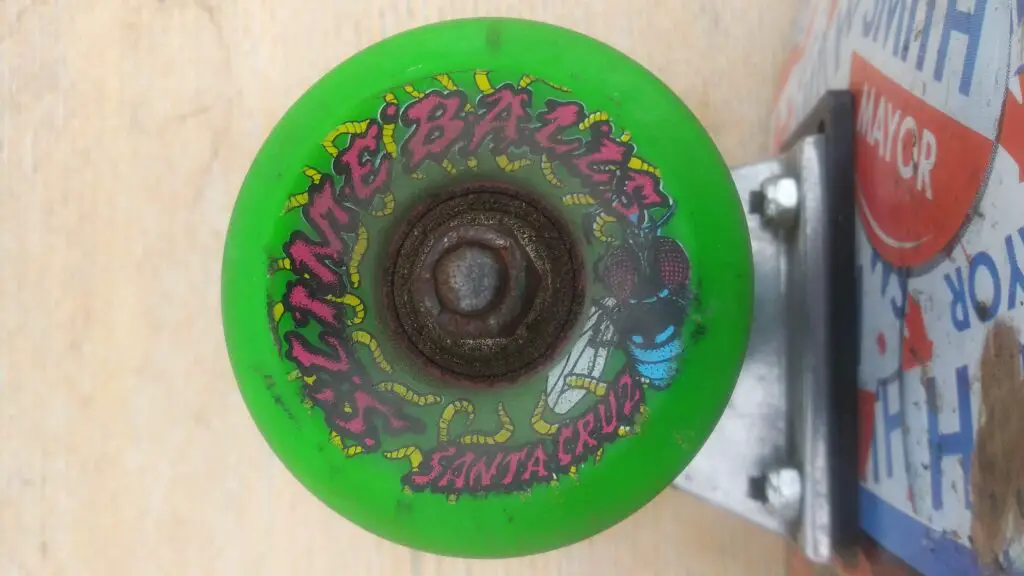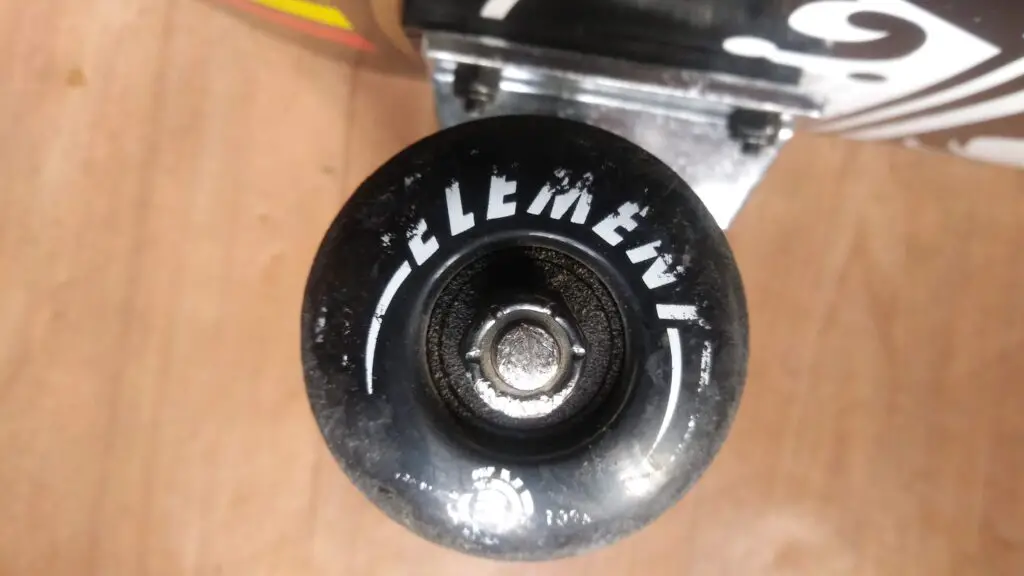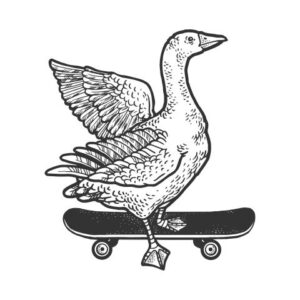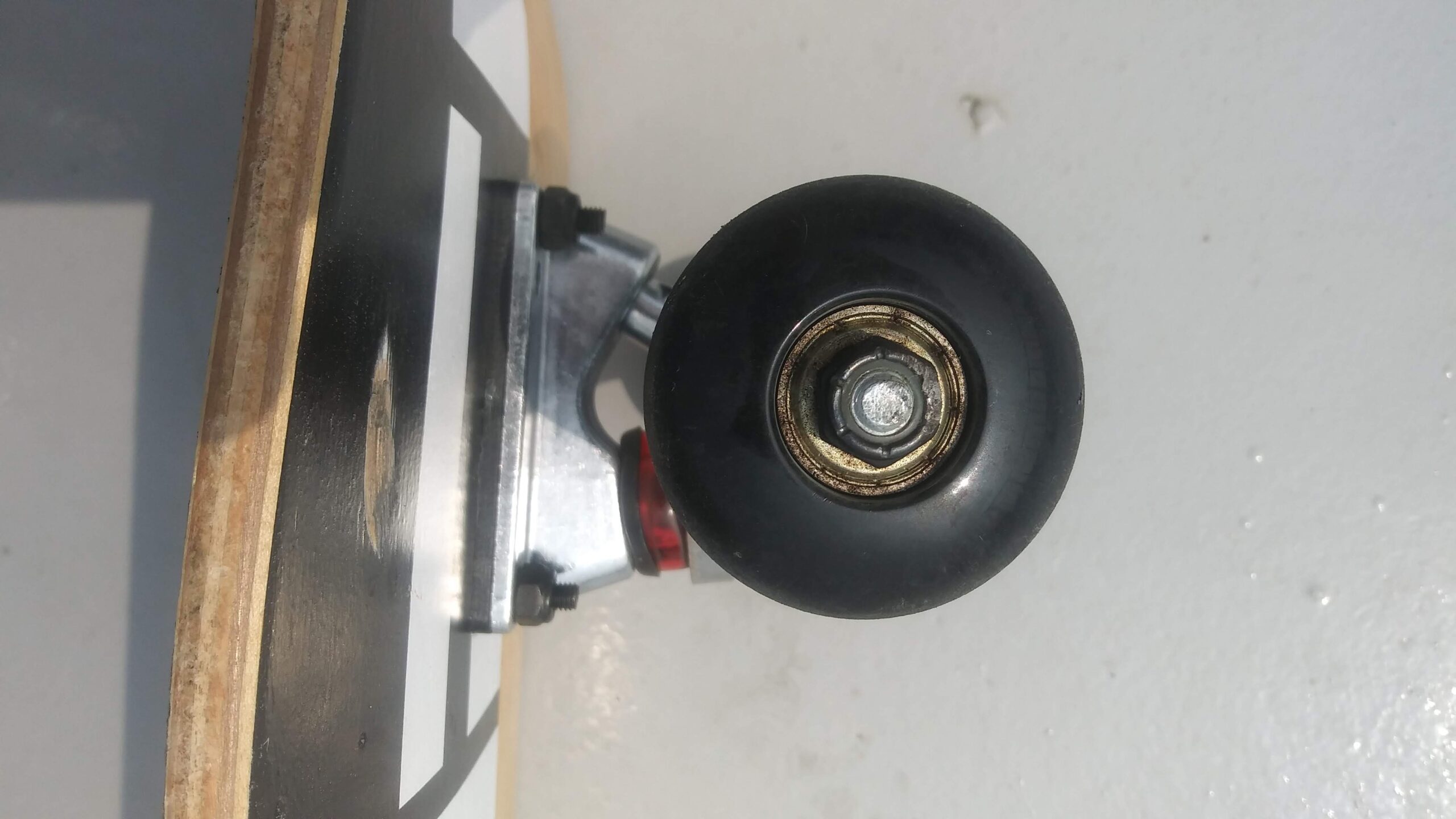Have you come across some markings such as 90A, 100A, or 75A on wheels while shopping for a skateboard? These are indicators of the durometer or hardness of the skateboard wheels. You might be aware that the wheel size affects a skateboard’s speed, but what’s the significance of wheel hardness in skateboarding?
The durometer, or hardness, of skateboard wheels determines how a skateboard performs, including its ability to withstand pressure or move fast. Some skateboard wheels are better for cruising on rough surfaces, while others are made for popping some tricks on soft surfaces.
So let’s just dive into it. You’ll find guidelines on how to measure wheel hardness, learn how to choose the best wheels for each skateboarding style, and discover the impact of the durometer on some aspects of this popular sport.
Defining Durometer for Skateboard Wheels
Durometer is the measurement of hardness for a skateboard wheel.
Hardness is a crucial factor to consider while making skateboard wheels as it determines a skateboard’s performance.
Manufacturers use polyurethane, a synthetic rubber, to make skateboard wheels. The material is stronger for longer and more interconnected urethane wheels; thus, the wheels are also hard.
For skateboarders, knowing what you want to achieve with your board will guide you on whether you need hard or soft skateboard wheels. Hence, before you hit the road, ensure that you’ve got the ideal set of wheels.
If you want to further nerd out about what material is used for skateboard wheels, what the chemical process is, and how to make skateboard wheels at home, then check out my complete skateboard wheel material guide.
Durometer Scales for Skateboard Wheels
Skateboard manufacturers use the Durometer Shore Hardness Scale to determine wheel hardness. It has several scale categories to measure the hardness of various objects. Most commonly used, the Durometer A scale ranges from 1 to 100 units, with wheel hardness increasing as the numbers increase.
Here’s a break-down of wheel hardness depending on the number on the A scale:
| Units | Wheel Type (hardness) |
| 78A – 87A | Very soft. Best-suited for cruising, smooth-riding, and longboarding on rough surfaces. |
| 88a – 95A | Somewhat soft. Less grip but withstands bumps. Well-suited for the streets and rough surfaces. |
| 96A – 99A | Hard. Average grip and speed. All-around wheels – perfect for beginners. Ideal for smooth surfaces and street skating. |
| 101A + | Hardest and fastest. Least grip – perfect for smooth surfaces. Best-suited for performing tricks and are professional wheels. |
Some skateboard wheel manufacturers use the Durometer B scale. It’s similar to the A scale, but it measures 20 units less. For instance, 100A (in the A scale) equals 80B (in the B scale). This 20-unit hardness allowance for harder wheels results in the B scale being more accurate than the A scale.
Here are different skateboard wheel types as determined by the B scale:
| Units | Wheel Types (hardness) |
| 81B – 82B | Extra-hard. Extremely little grip, ideal for professional skating. |
| 83B – 84B | Extremely tough for professional or technical skating. |
Comparison of Soft vs Hard Skateboard Wheels
Wheel durometer should always come to your mind when shopping for the perfect set of skateboard wheels. Well, you’re probably wondering how you’ll juggle through hundreds of wheels while determining their hardness on the Durometer scale. Worry not!
Nowadays, manufacturers have made it easier for skateboarding enthusiasts by putting graphics on the wheels indicating their hardness. When shopping for wheels specifically designed for certain purposes, look for such markings to find your ideal wheel type.
As we’ve noted earlier, skateboarding styles determine your choice of wheels, and specifically their durometer. You’ll not enjoy your ride if you use hard wheels to cruise through town or the countryside. The reverse is true if you want to perform an ollie, but with soft wheels.
To help you determine which type is best for you, here’s a detailed comparison of soft and hard skateboard wheels and how each impacts your ride:
Soft Wheels

If you’re a newbie in this sport, or you just love cruising on your skateboard, you’ll likely prefer this type of skateboard wheel. Soft wheels have a durometer ranging from 77A to 87A and are the best choice when training your kids on skateboarding.
In general, soft wheels are best suited for rough terrains. This is because they have greater shock absorbance capacity. Soft wheels provide smooth riding by compressing pressure. Therefore, you’ll not feel uncomfortable because they cushion the impact of the rough surfaces.
That said, soft wheels will not be ideal for smooth surfaces such as skate parks. They will make your ride unbearable on skate parks or indoor surfaces due to their tight grip. You’ll end up using a lot of effort to gain speed and not enjoy your ride.
Pros
- Best grip and shock absorbance
- Perfect for gliding on rough surfaces
- Easy to balance, push, and maintain speed
- Safer for maneuvering through obstacles like small stones or cracks
Cons
- More bouncy
- Not ideal for popping tricks
- Slower
- Unsuitable for professional or technical riders
- More likely to flat spot
Hard Wheels

These are your perfect choice of skateboarding wheels if you’re more experienced in the sport or love performing technical skills. Hard wheels range from 96A to 104A.
Unlike soft wheels, hard wheels will enhance your performance during technical skating. Since they have less grip and are lighter, you’ll find it easy to pop some skills as you skate at high speeds. The wheels work best on smooth surfaces, away from obstacles.
However, don’t try using hard wheels if you’re an amateur in skateboarding. It will be difficult to maintain your balance, as you need some experience to maneuver smooth surfaces as you accelerate. Moreover, you can’t ride the wheels on rough terrains as they will block if they come across any obstacle.
Pros
- Toughest and fastest type of skateboarding wheels
- Best for popping tricks, such as the ollie
- Perfect for professional skating
- Ideal for skateparks and street skating
- Less bouncy
- Lighter and more responsive
Cons
- Produce a lot of noise via vibrations
- Less shock absorbance capacity, thus unsafe for beginners
- Unsuitable for long-distance rides
- Not good for rough surfaces
Medium-Hard Wheels
They fall in between fairly hard and extremely hard skateboard wheels. If you’re a jack-of-all-trades and don’t want to stick to a specific form of skating, these are the kinds of wheels to consider. Medium-hard wheels have a durometer rating of 96A to 99A.
These skateboard wheels are best suited for newbies, and you can use them on not-so-rough riding, such as street or skatepark riding. In general, medium-hard wheels make it easier to keep safety and versatility both as your main agenda in the sport.
Overall, soft and medium-hard skateboard wheels are best for beginners and freestyle riders. If you’re not yet a pro, maintaining your balance should be your priority. Also, go for the soft wheels when you’re transitioning between skateboarding levels.
If you are thinking of finally getting a skateboard T-tool for adjusting your hardware, read about why it’s easily worth it and see the best and cheapest recommendations.
Best Wheel Hardness for Common Skateboarding Styles
Every skateboarder’s dream is to enjoy their ride to the fullest and achieve their skateboarding purpose. Whether you’re after recreational outdoor cruising, racing, or performing some technical skills, your style will determine the type of wheels to use.
Hence, different skateboarding styles will require specific wheel hardness. Here’s a list of some common skateboarding styles and the best wheel hardness to use for each:
- Cruising: 78A to 92A hardness. It requires soft wheels, such as the OJ Skateboard Cruiser Wheels (available on Amazon.com) that provide a smooth ride, especially on rough surfaces. These wheels are best suited for riding on sidewalks and asphalt parking lots.
- Longboarding: 73A to 87A hardness. It needs soft wheels that can withstand the pressure on rough surfaces and carry the extra-large board. The Orangatang Longboard Wheels are ideal for longboarding.
- Street skating: 99A + hardness. Street skaters need medium-hard to hard wheels to pop some skills while sliding fast. Spitfire Formula 4 Classic Wheels (available on Amazon.com). These have a 101A hardness, perfect for street and park skating, even on rough surfaces.
- Vert Ramp Skating: 99A hardness. Whether you’re a pro in vert ramp skating or are aiming to conquer the next level, hard wheels will come in handy. For instance, the Speedlab Wheels (available on Amazon.com) provide excellent performance due to their anti-slacking capacity. They also offer a great balance between enough grip and slide.
- All-round skating: 92A to 97A hardness. If you’re a freestyle skater and doing it all is your motto, you need wheels that can maneuver through different surfaces. These are hard wheels but with some grip to enhance comfort and safety, even at high speeds and sharp turns. As an example, the Powell Peralta G-Bones (available on Amazon.com) have a 95A durometer rating, are durable, and versatile.
Other Factors Affecting Performance of Skateboard Wheels
Apart from the durometer (hardness), skateboard wheel performance may vary depending on other factors. Hence, despite being a significant determinant of how your skateboard ride will be, wheel hardness is not the only thing you need to consider.
Here are other factors that determine the performance of skateboard wheels:
Skateboard Wheel Diameter (Size)

Skateboard wheels vary in size, and this explains why they have different speeds and/or performance. A wheel’s diameter determines its size. Like the durometer, the wheel size will depend on what purpose you intend to use your skateboard for.
As with wheel hardness, you’ll find that most manufacturers indicate a skateboard wheel’s diameter on the wheel. The wheel’s size is measured in millimeters, and it is mostly on the opposite side of its durometer.
Most skateboard wheels are within 50 to 75 mm or 1.96-2.95 in (the general range is 48-75 mm or 1.88-2.95 in). Smaller wheels have smaller diameters (lower numbers), and the reverse is true for larger wheels. Your skateboarding style will dictate what wheel size you’ll choose as it also affects speed and acceleration.
Even though smaller wheels are slower, they’re perfect for performing tricks and skating on smooth surfaces. They’re also lighter and lower than bigger wheels, making it easier to turn and control them. Therefore, they’re more likely to also be hard as they are well-suited for professional or technical skateboarding.
You’ll love them if you’re a pro skater and love street skating!
Contrastingly, larger wheels are heavier, fast-rolling, and more stable. They are higher than smaller wheels, making it hard for the rider to pop tricks with them. Hence, they’re the best choice for beginners, cruisers, and longboarders.
Here’s the size range of popular skateboard wheels and their corresponding skateboarding styles:
- 50 to 53 mm (1.96-2.08 in): They’re small and slower wheels. They perform excellently with smaller riders during street skating, bowl, skatepark, and trick riding. Options such as the Spitfire Formula 4 Classic Wheels (available on Amazon.com) with 52 mm (2.04 in) diameter are ideal for riding on such surfaces.
- 54 to 99 mm (2.12-3.89 in): They’re medium-sized wheels with average speed and balance. The wheels are best suited for bigger riders who enjoy street skating, bowl, vert, and skatepark riding. For example, the Slime Balls Vomit Mini Wheels> (available on Amazon.com) with 54-100 mm (2.12-3.93 in) diameter, are high-quality wheels that perform best on treaded surfaces.
- 60 mm (2.36 in): The wheels are well suited for rough terrains. They’re ideal for specialty riders who enjoy downhill adventures, riding longboards and dirt boards. You might consider the Powell Peralta “Rat Bones” (available on Amazon.com). These are pro longboard wheels with 70 mm (2.75 in) diameter bearings, and wheel spacers.
Contact Path
The section of a skateboard wheel that touches its riding surface is its contact path. Like wheel hardness and size, the contact path also contributes to the wheel’s performance. A wheel’s shape and size are the major determinant of its contact path.
Large wheels provide a large contact path. For instance, longboards have large contact areas that distribute the rider’s weight evenly on the skateboard. Therefore, they experience smoother rides as an extensive contact path minimizes pressure and rolling resistance.
On the other hand, smaller wheels have a reduced contact path. A rider on such wheels needs more experience to maneuver and counter the pressure as the small surface area increases rolling resistance. Hence, they’re more likely to experience bumpy rides, especially on uneven surfaces.
A wheels’ shape also determines its contact path. Round wheels have a smaller contact area than square wheels. Therefore, you’ll have a smoother ride on the square wheels as they’re more in contact with the surface than the round ones. For instance, large cruiser and longboard wheels have maximum contact paths, more grip, and protection to the axle nuts.
Wheel Quality

You may be tempted to think that a wheel is just like another if they have similar sizes, shapes, and durometers. However, a wheel’s quality is also a crucial distinguishing factor. While softer wheels wear out faster than harder wheels, poor quality hastens wheels’ dilapidation.
You may be tempted to buy cheaper wheels if on a tight budget. However, most cheap skateboard wheels are of low quality and become worn out sooner than expected. Well, if you’re a newbie and can’t afford high-end wheels, you can start your journey with affordable wheels and upgrade as you gain more skills.
Alternatively, renowned brands, including Bones, Spitfire, and CCS, manufacture high-quality skateboard wheels. Though they’re more expensive than low-quality wheels, these top-notch wheels are more durable. These are the type of wheels to use if you’re a professional rider who wants value for their money.
Bones and Spitfire are also among skateboard manufacturers who design wheels for a defined purpose. For instance, Spitfire F1 Street Burners and Bones STF Formula are best suited for street terrain. In contrast, Spitfire F1 ParkBurners and Bones SPF formula are ideal for parking areas.
Wheel Rebound & Bounce
Skateboards are bound to bounce while you ride them. Polyurethane, the synthetic material used in making modern wheels, contributes to the wheel bouncing. And in this case, wheel rebound simply means how fast a wheel reverts to its original shape and size after bouncing off the ground.
Since you can’t tell the quality of a skateboard wheel from its appearance, bouncing it is a perfect determinant. You only have to drop the wheel on the ground and note if it bounces back.
High-quality skateboard wheels have a higher rebound and will bounce back immediately. However, skateboard wheels made from low-quality polyurethane will have a very low rebound ability and thus have very little bounce.
In general, a standard skateboard wheel should go back to its initial shape after bouncing. Therefore, it’s wise to consider credible brands, such as Bones and Spitfire, because their wheels are renowned for being manufactured from high-quality raw materials.
If you’re a hardware nerd, check out my complete guide on skateboard bushings and how it is the cheapest way to customize how you ride.
Conclusion
Every skateboard rider wants to optimize their riding experience. Wheel hardness or durometer is one of the factors that skateboarders should always consider when choosing wheels for their boards. A wheel’s durometer will not only determine the skateboard’s purpose but its performance too.
However, apart from wheel hardness, size, shape, and contact path are major determinants of a skateboard wheels’ performance. To enjoy your ride, also ensure that you’ve sourced high-quality skateboard wheels that also suit your experience level.
So that’s it. Hope you enjoyed the read and look out for more content from Board and Wheels.
Sources
- Science Behind the Sport: Board Materials
- Warehouse Skateboards: Skateboard Wheels Buying Guide
- Smooth-On: Durometer Shore Hardness Scale
- Live About: How to Determine the Hardness of a Skateboard’s Wheels
- Skateboarders HQ: Skateboarding – Hard VS Soft Wheels Explained
- Surfer Today: How to Ollie on a Skateboard
- Shits Skateboard Company: Skateboard Wheels Buying Guide
- Skateboard Here: Skateboard Wheels
- Bones Skateboards: Homepage
- Spitfire Wheels: Homepage
- CCS: Homepage





